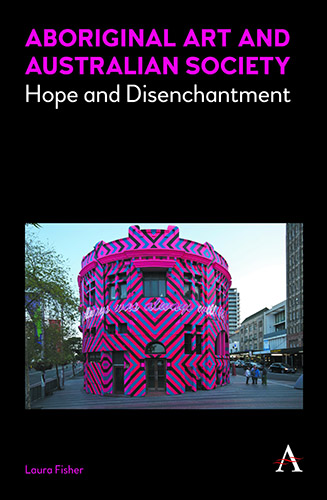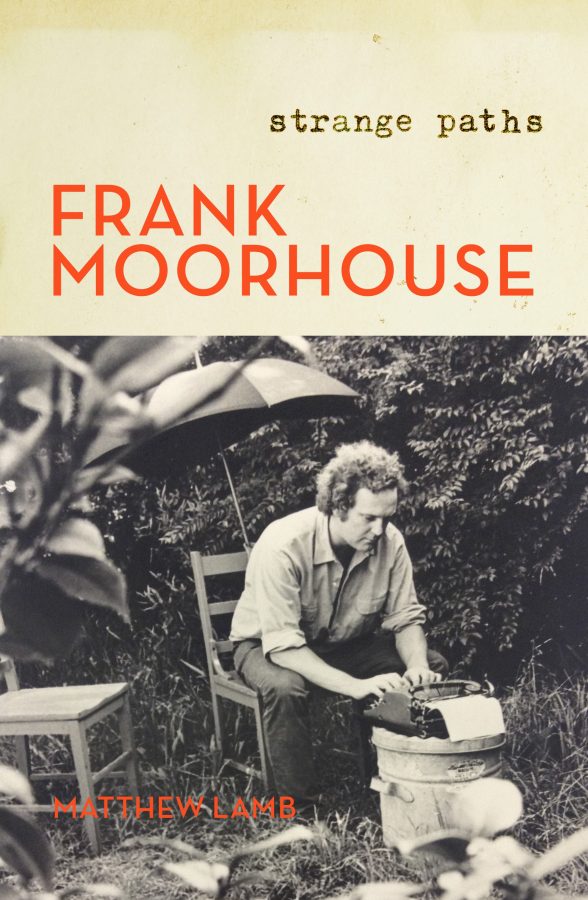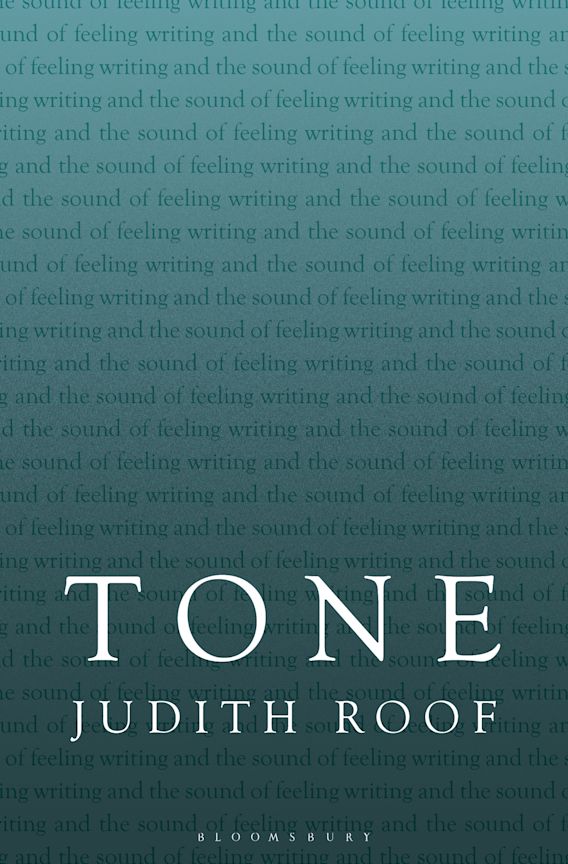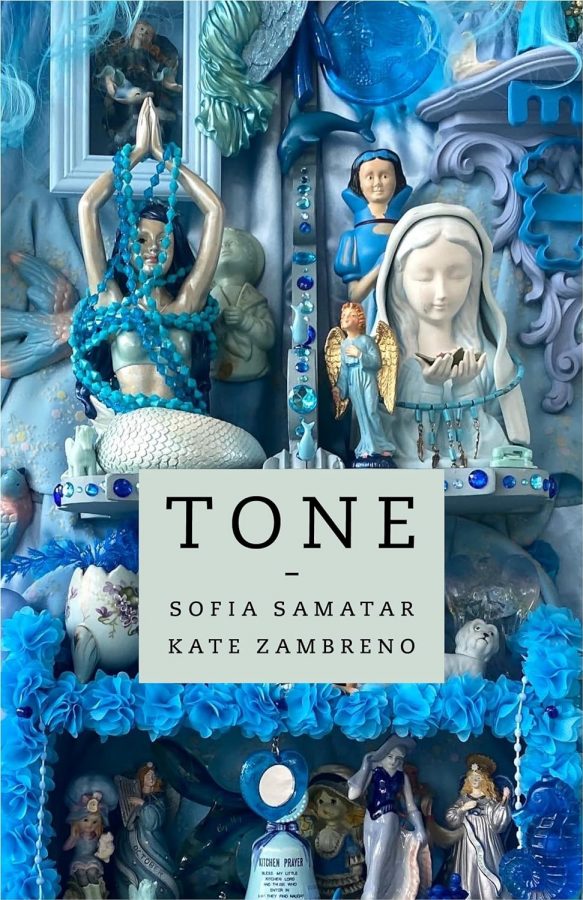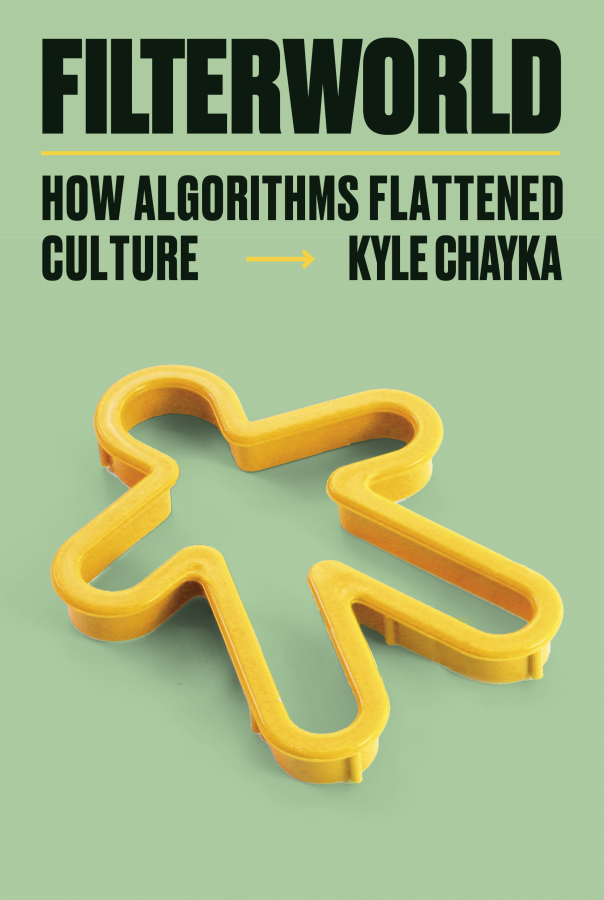Notwithstanding widespread pessimism about the relationship between non-Indigenous and Indigenous Australians, Laura Fisher believes that there is much goodwill between the two groups, and that one vehicle of this goodwill is the emergence of ‘Aboriginal fine art’, as a beautiful and conceptually rich voice for a minority long despised, ignored and insensitively managed. Her book Aboriginal Art and Australian Society is a sustained effort to ‘make strange’ this pleasing phenomenon and to draw attention to its necessary fragility. This is not a study of Aboriginal art but of the way that Aboriginal art has been written and spoken about, mostly in Australia, since the 1970s. Fisher’s object is not only ‘art criticism’, as that phrase is usually understood, but also policy discourse in which Aboriginal art is understood to be a means to an end.
Fisher brings art criticism and policy discourse into the one frame by making two moves that are foundational to her project, which began as a PhD thesis in Sociology. (Disclaimer: I was one of the examiners of this thesis.) One move is to treat all ‘writing on Aboriginal art…[as] an avenue for ethical action in the post-assimilation era’. A shared premise of writing about Australian Aboriginal culture is that Australia, as a settler colonial society, is now facing up to its unjust dealings with Aboriginal people: to engage with Aboriginal Australians is to participate in diversely conceived projects of national redemption.
Fisher’s other foundational move is to employ sociological concepts that distance her from the claims that fine art makes about itself. Anthropologists Alfred Gell and Fred Myers have shown that the meanings of art and the terms in which art is valued are socially determined. Pierre Bourdieu’s concept of ‘field’ enables her to consider the relationships among multiple regimes of value and meaning. When social practices – such as making, trading and representing Aboriginal art – are postulated as occupying a field, then it is possible to understand each practice in terms of its position within that field. Á la Bourdieu, one can tell stories of actors’ ‘position-taking’ within that field; for an actor to take a position is to mobilise one of the ethical/aesthetic/policy ideals that the dynamics of the field have generated.
By mobilising Bourdieu, Fisher herself ‘takes a position’. Bourdieu’s sociology of taste is a critique of the idea that cultivated taste mobilises aesthetic values that are in principle universal. A rigorous relativist, Bourdieu insists that there is no taste that cannot be comprehended as a position taken within a socially constituted field, a position whose taking participates in the reproduction of a structure of social classes. So the claim that there is ‘Aboriginal fine art’ and that it is part of the global heritage of ‘fine art’ – a claim with commercial, curatorial and academic entailments – provokes Fisher’s sociological suspicion. However, ‘suspicion’ is not hostility or derision. Fisher’s practice of critique is always empathetic with its objects. Cultural respect and sheer aesthetic pleasure draw her to the idea of ‘Aboriginal fine art’, and her research practice has included interviewing people deeply invested in that idea. However, her persistent theme is that the category ‘Aboriginal fine art’ is precarious, and the aim of her argument is to persuade us that it could not be otherwise.
Since the 1970s two themes of public culture in Australia have entwined: that Australia is a culturally sophisticated and progressive nation and that we are committed to reconstituting, in just terms, the relationship of settler Australians (immigrants and descendants of immigrants) to Indigenous Australians. In the 1960s, the persistence of Aboriginal art became proof that Australia had not extinguished Aboriginal culture. To respect Aboriginal culture has not only affirmed difference, it has opened us to the historical understandings the art could present: stories of dispossession and suffering. In the 1980s and 1990s, the ‘moral calibre of the settler state’ became implicated in the public figuration of Aboriginality.
This public Aboriginality was pan-Aboriginal, encouraging urban cultural activism, not just the restorative affirmation of remote Aboriginal culture. Fisher here introduces a theme: that traditional and urban Aboriginality have been affirmed in different terms; the selective recognition of ‘land rights’ made it possible for the ‘urban’ to feel marginal to the more confidently and warmly affirmed ‘classical’, remote Aboriginal people. Thus,
urban Indigenous artists, curators, writers and professionals (and their non-Indigenous supporters) have treated the art arena as a surrogate state – a domain that can be radicalised and democratised and compelled to provide the Indigenous subject with the recognition that the actual state withholds.
Since the 1970s, the state has subsidised Aboriginal art not only because of its intrinsic worth but also as a corrective to Aboriginal poverty. Making it easier to trade art stimulated its production. To see art as income-generating employment has added to, and thus complicated, the ways that Aboriginal art has come to be seen as valuable.
At the same time, Aboriginal art was welcomed into ‘state endorsed commemorative events, discourses and forms of public culture’, with the avowed aim to enrich the nation aesthetically and ethically. For example, Fisher describes the Australian Heritage Commission’s ‘Art of Place’ National Indigenous Heritage Award and its touring exhibitions as ‘a government arena in which connections could be drawn between the gravity of Aboriginal land custodianship and nationalistic ideas about environmental and cultural heritage’. There were many smaller public art projects, giving rise to ‘a recognisable Indigenous aesthetic in Australian public culture’. (The ubiquity and possible banality of that moralised aesthetic has been satirised by Chris Lilley and by the ‘Black Comedy’ team.)
The meanings of such work remain open, Fisher suggests. She implicitly responds to the more pessimistic connotations of the late Patrick Wolfe’s phrase ‘state-conceded Indigeneity’. Fisher sees this public culture’s ‘Indigeneity’ not as masking an underlying settler-colonial drive to ‘erase’ and ‘eliminate’ the Indigenous presence but as ‘spurs for intercultural dialogue’ and as openings for Indigenous agency. Contrary to Wolfe’s reductive and teleological hermeneutic, her theme is the discordant multiplicity of ways that ‘Aboriginal art’ has become valued.
Here Fisher pauses to offer four reasons why commentaries on ‘Aboriginal art’ have tended to render it metonymic of ‘Aboriginal culture’. First, painting has become associated with land ownership and with ecology – themes linked in the world-view of ‘left-leaning civil society’; in combination, they display the ‘sophistication and intelligence’ of Aboriginal culture. Second, Aboriginal art is a fitting emblem of Australian nationhood as ‘youthful and progressive yet with ancient roots’ because the art ‘embodies both the historicity and contemporaneity of Aboriginal culture’, and this makes it a ‘rare platform for Aboriginal advocates and non-Aboriginal representatives of the state to sing in tune’. Third, public and private investment in Aboriginal art and its global critical and commercial success are understood to be fillips to the historically damaged pride of Aboriginal Australians. Fourth, so many representations of contemporary Aboriginality are negative that Aboriginal art is the safe ground of ‘affirmative engagements with Aboriginal identity’.
Within Australia’s visual arts world in the 1980s, critical discourses and artistic practices helped to mediate Aboriginal art – that is, to frame Aboriginal art in terms that made it relevant to other concerns. Fisher’s sixth chapter deftly summarises some of them; again, it is the lively discordance among these mediations to which she invites attention. Fisher draws on work (criticism, but also artworks themselves) by Ian Burn, Terry Smith, Bernard Smith, Imants Tillers, Tim Johnson, Vivien Johnson, Tony Fry and Anne-Marie Willis, Eric Michaels, Paul Taylor and others. Many artists and critics were keen to devise ‘a new individual and collective relationship to the international art world’ through new understandings of Australian tradition.
There was talk of ‘cultural convergence’ between Indigenous and non-Indigenous. Landscape – so central to the Australian tradition – could perhaps be radically reconceived under the stimulus of Aboriginal visual vocabularies of place. Meanwhile, widespread interest in a post-colonial humanities raised the question of the terms in which the art of colonised peoples could now be valued. The term ‘appropriation’ acquired currency, promoting awareness that recognition could unguardedly re-assert colonial relations.
In yet another mediation, postmodern and conceptual currents in the art world found ways to invoke Aboriginal art in their questioning of the idea of an ‘Australian art’ authentic to nation; Aboriginal art also illustrated powerfully ‘the primacy of idea over object in conceptual art’. Pervading this eruption of critical creativity was a widespread awareness that the society in which Aboriginal art was acquiring significance was the still unjust product of a colonial history: were the newly hallowed Aboriginal artists agents or victims? As well, there was a very Australian sensitivity to the perception of Australia from Northern Hemisphere art worlds, including an alarmed feeling that the art of non-Aboriginal Australia could be marginalised by the metropole’s exoticising attention to Aboriginal Australia’s renascence. Through this medley of hopes and anxieties, Aboriginal art riveted the attention of many thoughtful Australians in the 1980s and 1990s.
The terms in which Aboriginal difference could be known, understood, relished, admired are Fisher’s concern in Chapters Eight and Nine. There were four facets to the ‘difference’ of Aboriginal art: it was the product of the socio-economically ‘disadvantaged’; it was the premodern primitive and tribal, now available to modern consumers; it was making conspicuous a tension, within pan-Aboriginality, between the marginal but audible urban voice and the venerated but less heard remote voice; it encoded arcane knowledge that could be elucidated by experts (anthropologists). In combination, these four facets of difference made Aboriginal art both ‘attractive and repelling’, enabling the ‘rehearsing, testing and disrupting’ of ‘particular ideas about Aboriginality’. That settler-colonial Australia should find Aboriginal art so troubling was a destiny, Fisher implies, that it should not seek to avoid. Her book makes a friendly commentary on the Australian art consumer as tourist discovering the strangeness of her land.
One large dilemma for dealers and consumers was whether it was necessary for each art object to come with a mythical story attached. Was ‘the story’ intrinsic to the object’s meaning and thus indispensable? Or was it better to acknowledge our incapacity for that kind of knowing, so that we could be free to enjoy the painting on our terms as superbly innovative abstract or stylised mark-making on a two dimensional surface? Fisher respectfully introduces the latter, formalist approach that ‘underpins the art’s value as contemporary fine art’, noting that Margaret Preston not only commended but enacted (in her own work) that approach. However, as high quality ethnographic research has accumulated, focused mainly on painters from Arnhem Land and from the Western Desert, it has been impossible to ignore the alternative to formalism, and so Fisher devotes a chapter to the ‘art/anthropology binary’.
The danger of accepting ethnographic explanations of Aboriginal art was that it would make it more difficult for Aboriginal art to break out of the ethnological museum, where it had long been intelligible as the anonymously produced artefacts of a disappearing primitive culture. Formalist reading would emancipate the art and the artists from that way of seeing Aboriginal art, rendering the individual artist as our contemporary and our equal in artistic sophistication. Fisher points out that as long ago as 1950, innovative anthropology began to offer contextual readings of Aboriginal art that avoided the museum’s anonymising and obituarising tendency. In Meanjin Ronald and Catherine Berndt presented art from Arnhem Land as a contemporary Australian school of art whose contextual meanings were discoverable.
The Art Gallery of New South Wales began to collect art from Arnhem Land in the late 1950s, and in 1960-1 the AGNSW put together a touring exhibition of 73 works. Ronald Berndt edited a book of essays and pictures based on that show. The essays included a debate between himself and Tuckson (the AGNSW’s Deputy Director, an abstract expressionist painter and private collector of paintings Arnhem Land) in which Berndt reiterated the importance of the context of production to the emergence of meaning, with Tuckson emphasising the extent to which the beauty and meaning of the paintings was universal. Acceptance of his view encouraged major public collectors to buy, and it primed collectors for the emergence of the Papunya School in the 1970s.
The polarity expressed by Berndt and Tuckson in 1964 still echoes. One reason for this persistence is that each side has continued to enjoy institutional support: the university supports ethnographic research that informs some art curation, while art galleries have sustained the modernist aesthetics from which Tuckson wrote. As well, Fisher argues, modernist aesthetics has been ambivalent about the spiritual and religious meanings of art. On the one hand, modernity has cast spirituality and faith as pre-modern and primitive; on the other hand, art for art’s sake had been sacralised.
The contextual explanation of Aboriginal art invited viewers schooled in modernist aesthetics to empathise with Aboriginal spirituality that they neither needed nor felt comfortable with. In making this particular observation, Fisher has perhaps understated the Christian mediation of Aboriginal art. Missionaries in Arnhem Land and Central Australia helped to establish the trade in what they then called ‘Aboriginal curios’ as far back as the 1930s. Missions were also by far the most important institutional hosts of anthropologists, working in remote Australia from 1920 to 1970, who compiled the ethnographic record from which Ronald and Catherine Berndt spoke in 1950. Liberal Christian missionaries such as Edgar Wells (Milingimbi, Yirrkala) looked for congruities between Christian and Aboriginal senses of the sacred, and some mission churches were decorated with sacred designs.
Of course there were strands of missiology that were hostile to Aboriginal religion, so it is important to understand Australian missions as a field of quiet and persistent contest about how to deal with Aboriginal tradition. To the extent that mission cultures afforded a place for Aboriginal spirituality, the sacredness of land to people became forcefully apparent to some missionaries who became influential advocates of land rights from the 1960s. Within the world of Australian art, the annual Blake Prize (not mentioned by Fisher) is but one ritual assuring a persistent discourse of the sacred/ symbolic through which Christian Australians were made receptive to Aboriginal art as materialisation of spirit. When art from the Kimberley became prominent in the market and in critical recognition, the impact of two or three generations of Catholic missions in that region was evident in some of the work (as revealed in the 1991 film The serpent and the cross by David Young, Chris Hilton and Belinda Nolan).
Anthropology’s credentials as a necessary and sympathetic translator of Aboriginal meanings have been undermined by historical narratives that cast anthropology, the state and the churches as dedicated to a colonial project of cultural erasure. Fisher argues that voicing that critical narrative has been an important element in the formation of ‘the urban Aboriginal artistic and intellectual consciousness’. In that perspective, salvage anthropology’s focus on the classical Aboriginal culture of remote Australia has contributed to marginalising the longest dispossessed (least ‘authentic’) Aboriginal people of south eastern and south western Australia. (Fisher could have quoted here Ronald Berndt’s advice to ‘part-Aborigines’ in the late 1960s: study the ethnographic record lest your ‘Aboriginal identity’ be poorly informed.)
Through exhibitions such as Aratjara (1993-4) urban Aboriginal artists have asserted the worth of Aboriginal art that is beyond ethnographic mediation. She highlights the advocacy of Gary Foley, Margo Neale, Chicka Dixon and Richard Bell in challenging preconceptions of ‘Aboriginal art’ with which anthropology has been complicit. The urban critique of anthropology’s authority to mediate Aboriginal art lent further support to ‘the prioritisation of form over content/meaning and the eschewal of spiritual content, as being fundamental to a progressive approach to remote Aboriginal art….To reject Anthropology and embrace Art is to make a political statement of opposition to primitivism and racism.’
Up to this point in her book, Fisher has shown how ‘the principles of transcendent aesthetics and artistic autonomy’ became so influential in the Australian and global recognition of Aboriginal art as ‘fine art’ since the 1970s. That is, the tendency of the positions taken in the social field of actors trading, curating and writing criticism was to favour a reading of Aboriginal art ‘in a humanist vein, to bring about some equality of treatment through a universalist lens that transcends the discriminatory practices of the past’ and that encourages readings of the art that do not require ethnographic knowledge. Her account of this social field as tilted towards the formal and universalising reading of Aboriginal art has a curious feature: among its many actors the remote region artists are implicit, mediated to the art field, as she says, by their relationship with anthropologists . In the last third of her book, remote Aboriginal artists become more visible, and they are present in the field not only as originators of meanings but also as traders whose behaviour, enabled by market forces, makes ‘Aboriginal fine art’ a ‘precarious’ category.
From the late 1980s to the Global Financial Crisis, Aboriginal art sales boomed, and this included the emergence of a prosperous secondary market. The boom accentuated ethical discourses focused on the poverty and vulnerability of the artists, the malfeasance of dealers, the vitiation of quality. To manage the threats that accompanied commercial success, the state subsidised art centres who collaborated with a ‘collegiate’ of dealer/curators; armed with a discourse of ‘cultural integrity’ they invigilated ‘entrepreneurial’ dealers and worried, in sympathetic terms, about opportunistic artists. In 2007 the Senate Standing Committee on Environment, Communications, Information Technology and the Arts held an inquiry into the Indigenous Arts and Crafts sector, and Fisher draws on submissions to it. Emphasising that her intention is not to judge, she elucidates an emerging discourse about virtuous and malevolent market conduct. Whether there has been exploitation is not her question: rather her focus is the fragility of the ideas and practices of ‘Aboriginal fine art’: ‘the despoliation of a fine arts movement through the widespread transgression of its core principles and standards…’.
By 2007, the boom had allowed two commercial models to form. In the service of Aboriginal art as ‘fine’ art, certain city-based dealers collaborated with art centres in staging exhibitions and managing artists’ careers (and tolerating slow sales as reputations were built); they had sold their conscientiously provenanced work on consignment, putting effort over time into cultivating a relatively small number of collectors. This ‘fine art’ style of commerce had encouraged commitment to non-commercial values, the disinterested love of fine art for its intrinsic value, as if the world of art could be autonomous, dedicated to art’s revelations.
The boom had also encouraged entrepreneurial dealers who were usually not long in the art business. They had sold art from crammed stock rooms at a range of prices to tourists (plentiful in Alice Springs). They sourced their stock not only from subsidised art centres but also from sites of production that they themselves hosted, backyards and sheds. (I once knew a pastoralist-cum-dealer not far from Utopia who astutely noticed that the Aboriginal people camped on his lease had taken up painting).Their relationships with artists were intermittent and poorly documented, and transactions were not only in cash but in goods for which the artist stated an immediate need, including alcohol. The ethos of the entrepreneurial dealers is more frankly commercial, indifferent to connoisseurship. (Alice Springs looms large in Fisher’s examples of entrepreneurial art commerce, and it has a longer history than she mentions. In the 1950s, the Welfare Branch sought to manage the trading of works by the Hermannsburg/Namatjira artists, for reasons that prefigure the ethical claims – about dealers’ and artists’ motives, about art quality – of the late twentieth-century ‘fine art’ collegiate that she describes here.)
What makes ‘Aboriginal fine art’ a precarious project is that the opportunistic agency of some artists connects these two commercial worlds, threatening the Aboriginal fine art world’s sense of being different to entrepreneurial circuits of production and trade. In evoking some artists’ willingness to produce art for any trader, whenever prompted by material need, Fisher populates the social field of Aboriginal art with Aboriginal actors who are problematic from the point of view of ‘Aboriginal fine art’. Unlike the urban Aboriginal artists with articulate arguments about what ‘Aboriginal art’ is or is not (such as the critics of anthropology’s influence who tended to reproduce a ‘fine art’ model), these remote Aboriginal disruptors are not named by Fisher, and they have no institutional identity other than as the occasional clients of the entrepreneurial dealers. She does not stigmatise these opportunistic producers, though she observes that those who enact the entrepreneurial trade are understood in negative terms when ‘fine art’ commerce maps the industry’s ‘ethical and unethical conduct, good and bad art, love of art and love of money’.
Detaching her account from the normative language employed by the agents of ‘Aboriginal fine art’, Fisher – qua sociologist – notes three effects of the fine arts entrepreneurs’ ethical distinctions. One is ‘to exclude a large body of Aboriginal art works from the consecrative pathways associated with fine arts institutions, prizes and high-end resale market.’ Another is to assist dealers to maintain an exclusive association with artists, ‘an association which allows them to better emulate the manner in which a non-Indigenous artist’s career is managed’. A third is to uphold a model of Aboriginality as ‘cultural’ rather than as materialist.
Fisher’s forensic stance towards the ideological buttresses of ‘Aboriginal fine art’ does not commit her to defending the practices of the entrepreneurial wing of the Aboriginal art industry. Rather the distinctive practice of sociological critique is principled non-belief, a detached curiosity about all positions taken in the social field. She calls it ‘adopting a reflexive position on the presuppositions of fine arts ideals’. Fisher acknowledges that such neutrality is difficult for her to sustain, as she knows that Aboriginal artists have often been victims of exploitation and that ‘the sustainability of the Aboriginal art market depended on collectors’ belief that the market has integrity’ . She admires the work done by remote region art centres. On the other hand, she empathises with artists’ reasons ‘to participate in a cash economy in which their art may be valueless from a fine art point of view, but valuable to them in the short term’, and she notes that much ‘Aboriginal artistic labour’ in remote community contexts is collective, repetitive, not primarily dedicated to aesthetic excellence, stimulated by customs of demand sharing that militate against the artist’s rise out of poverty. The habitus of the remote artist, in short, is an awkward fit to the fine arts world’s model producer.
Fisher devotes her final chapter to showing that Aboriginal fine art is but one part of a large visual culture that began around the middle of the twentieth century consisting of ‘craft objects, carvings and artefacts…Aboriginal-themed souvenirs, furnishings and graphic design’. Missions and advertising agencies contributed to the circulation of artefacts made by both Indigenous and non-Indigenous people. From the 1970s Aboriginal people began to discipline this trade by asserting intellectual property rights; licensing was not intended to extinguish ‘Aboriginal mass culture’ but to redistribute its returns and to place some protective barriers against desecration.
Domestic ‘outback’ tourism has propagated ‘Aboriginalia’, and the Bicentennial celebrations of 1988 and the Reconciliation civics of the 1990s further boosted demand. Qantas made its aircraft a surface for dot paintings. Proliferating Aboriginal-themed commodities have generated economic returns for both Indigenous and non-Indigenous Australians, in line with such government policies of socio-economic improvement as ATSIC’s Cultural Policy Framework (1995). ‘Aboriginal fine art’ is ‘precarious’, Fisher argues, because it is but one part of a flourishing ‘Aboriginal culture industry’. ‘If the value of fine art is predicated on our appreciation of it as unique, authentic and clearly differentiated from mass produced commodities… we can see why Aboriginal fine art is enervated by these associations’.
Addressing the themes of Australians’ post-colonial good will, Fisher joins a small but growing band of mainly female writers that includes Sara Ahmed, Tess Lea and Emma Kowal. With sympathetic curiosity, they have described the images, vocabularies, tropes and blind spots of Australian anti-racism and post-colonial aspiration. Fisher’s account of this cultural formation is so perceptive because it starts with the anti-essentialist idea that settler-colonial good will towards Indigenous Australians is a field of positions-taken, each in some tension with others. The ensemble of ethical commitments that she documents with prolific quotation from publications and interviews emanates from, and is secured by, a variety of institutional interests, routines and policies. Aboriginal art has been diversely ‘instrumentalised’ as serving: ‘strong Indigenous identity, revitalised culture, economic participation and a rich and inclusive sense of nationhood’. Her book is a superb demonstration of the value of Bourdieu’s concept of field in describing a sensibility as complex as settler-colonial auto-critique.
What can we learn about contemporary Australia from Fisher’s demonstration that the significance of Aboriginal art is so ‘fluid’ and that ‘Aboriginal fine art’ is a ‘precarious’ project? Fisher sees Australians as inheritors of both Romantic notions of culture and the critique of Romanticism. What Australians and others invest emotionally and intellectually in Aboriginal art is their protest against two modern things: capitalism’s attrition of ‘our creative and communal selves’ and its vitiation of our relationship with the natural world; and ‘the rarification of Western fine art: its elitism, its esoteric tendencies and its status as aloof from the day to day.’ At the same time, Australians are invited by empowered urban Aboriginal artists and curators to be disenchanted, in one sense, with Aboriginal art – that is, to concede that ‘having decided to acknowledge the validity and value of Aboriginal culture in the post-assimilation era, non-Indigenous Australians then embraced those forms of Aboriginal culture in which the repercussions of the colonisation process were least evident’. The urban Aboriginal artists and curators are in another way supporters of ‘Aboriginal fine art’ as a realm of truth and freedom in which they are bound only loosely, if at all, by the customary contexts of remote region art-making.
By exposing the embattled fragility — the ‘pathos and perversity’ — of Australians’ interest in Aboriginal art as fine art, Fisher wishes to persuade us that as settler colonists we inhabit and perform a dialectic of hope and disenchantment. In a more implicit way, she points to the ambivalence of the urban Aboriginal challenge to ‘Aboriginal fine art’.
